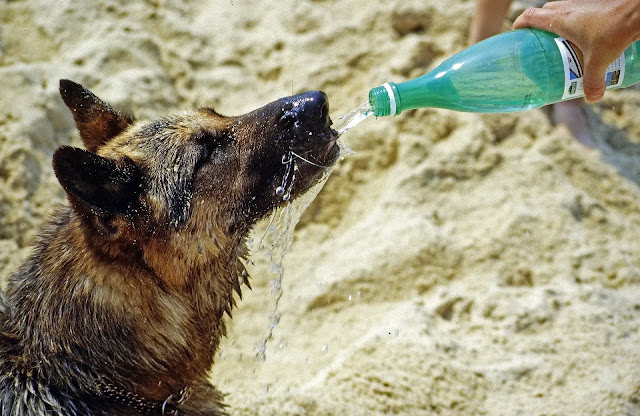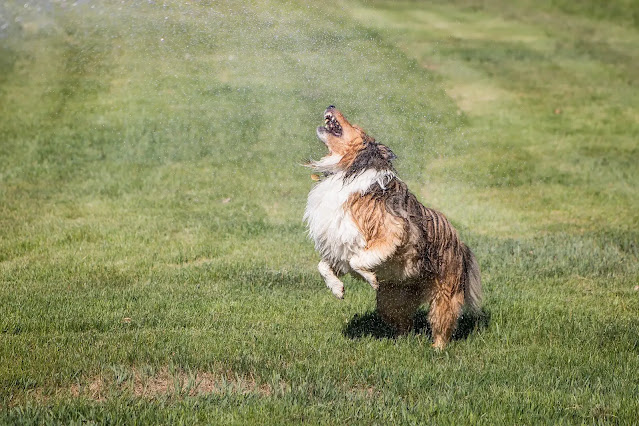Since I am a pet owner; I always follow a general rule of thumb: “If it’s hot for you, it’s hotter for your dog.” Here are some tips for protecting your pet from the summer heat.
Jason Nicholas says: A veterinarian and chief medical officer of Preventive Vet says that when the temperature reaches around 27 degrees Celsius (which seems low compared to record temperatures in recent years), pet owners should take precautions, he also adds. that he witnessed many cases of heatstroke in dogs; It is a fatal condition. But it can be completely prevented.
Why can’t dogs survive the weather that humans can? Dogs and humans are two different types of animals, with different abilities to tolerate temperature. We are distinguished by a large, sweaty organ that cools us from our head to the soles of our feet. which is the skin; But dogs’ thick fur makes it difficult for them to escape the heat.
Instead of sweating, the primary way dogs’ bodies lower their temperature is by panting. This deep and rapid breathing expels the heat, and causes the moisture to evaporate; which cools the blood of dogs in their mouths and tongues, however, some conditions cause this mechanism to be disrupted, in conditions of high humidity evaporation become slower; making it impossible to lower a dog’s internal temperature even in a shady place.

In addition; This mechanism of reducing heat does not work equally efficiently for all dogs. Take the types of dogs with flat faces, for example. Like the “bug” or “Pekingi”, these dogs suffer from breathing, as they will suffer more when the weather is hot, and the same applies to elderly dogs or those with breathing problems. Puppies are more susceptible to heatstroke because they are not fully developed. Which means they don’t have the same temperature-regulating mechanisms as adult dogs. If you have a flat-faced puppy, he may suffer from heat problems at temperatures around 24°C.
Since the responsibility of helping dogs beat the heat rests with the owners; We looked for some tips to help you protect your pet in the summer.
1. Leave your dog at home
It seems impossible to get out of the house and leave the dogs alone. Some of us cannot go shopping or buy a cup of coffee without taking our dog. However, when it is very hot, the best place for your dog is at home, besides the air conditioner.
But some dogs become hyperactive and nervous if they are confined, and if you decide not to go out one day, don’t worry; This does not mean that your pet will not exercise on this day.

Activities are not just physical pursuits, claims Nicholas. People don’t know how exhausting it is to play mental games like hide-and-seek or train canines in new skills.
You can try interactive dog puzzles or treat mats (soft mats in which treats are hidden for dogs to find), and if you are not at home to teach your dog new tricks; Leave a treat-packed, frozen chew toy (such as peanut butter or Greek yogurt) for him to play with.
2. Keep your dog safe under the sun
If you have to take your dog outside, the first piece of advice is to never leave him in a hot car, not even for a second. There are a lot of warnings about this, but unfortunately; Many people still make this mistake. Even if the car’s air-conditioning is on, vets like Nicholas say it’s not worth the risk anyway. It doesn’t take long for temperatures to reach deadly levels in a closed car, and blackened dashboards and seats can make the temperature reach 93. Celsius.
While the outdoor temperatures do not reach this staggering number; However, leaving dogs in direct sunlight is not a good idea either; Spending a few minutes in these conditions can quickly lead to heat exhaustion. Humans can tolerate and even enjoy heat for longer periods because the slippery, sweaty skin cools the body; But hairy dogs can’t do that.

however; You’ll have to walk your dog eventually, and although we can’t hide from the heat forever. However, we can avoid the times when temperatures reach their maximum. Nicholas advises getting out of the house early in the morning and evening when the air is a bit cooler, and when you do venture outside, keep your outings brief and bring water for your dog to drink.
But what if your dog is hyperactive and loves to run around? The solution may seem counterintuitive, But in hot weather conditions; Outdoor activities for these dogs should be limited to walking only. Running increases your heart rate, and muscles that work harder produce more heat. For humans, the sweat we produce while exercising is an instant air conditioner; But this does not apply to creatures that cool their bodies through the mouth, dogs should stick to more sedentary activities, at least until temperatures drop.
3. Prepare the appropriate equipment
To protect your pet when you go outside; Make sure you equip him with some protective equipment, for example; If you have a dog that needs to wear a mask while walking, Nicholas advises making sure the mask doesn’t stop him from panting, and he says he sees a lot of dogs on hot days unable to open their mouths, let alone pant.
Because they are unable to release heat, dogs suffer as a result, claims Nicholas. Try to use rubber or vacuum masks so that dogs can pant while they are wearing them and cannot bite at the same time.
How do you keep dogs cool?
Dogs’ mouths aren’t the only organs that need treatment during hot weather. As temperatures rise, so do sidewalks, which might sound silly (and super funny too); But Nicholas says dog shoes (which he prefers to have rubber soles) can protect their feet from burns.
If your dog does not accept shoes, you must do something to protect his feet. Nicholas says: “Try to walk on the grass, and walk in the shade if you can.” He also advises avoiding sunny beaches.
In addition to shoes; Another summer option that’s acceptable for dogs is; They are “cooling jackets”, as their name appears; They are wet jackets that you wrap around your dog before going out for a walk, as they facilitate evaporation and help cool the dog’s body.
4. Summer skin and fur care
If you own a shaggy-haired dog like the Chow Chow or Sheepdog, you might think it would be a good idea to cut his hair during the summer. But fur is not only useful for keeping animals warm during the winter; on the contrary, it cools and protects the skin at the same time.
When summer comes, dogs replace their inner winter coat with an outer layer; This lighter layer of hair insulates dogs’ bodies, keeping heat away from them. In addition, when dogs run, this thin layer moves up and down, acting as a fan to cool the skin underneath.

To take care of this summer layer of fur, and to protect your pet; Nicholas advises combing it; He says: “Combing dogs helps to get rid of the inner layer that is being replaced, and this layer preserves additional amounts of heat.”
The summer fur coat protects dogs from UV rays. Nicholas advises against shaving dogs since it raises their risk of skin cancer and sunburn. If you cut your dog’s hair beforehand, or if your dog is bare-chested like the “Chinese Crested” dog; You can protect his skin with Epi-Bet; It is a sunscreen cream for dogs, approved by the US Food and Drug Administration, and for light-skinned dogs; Use the same cream on exposed areas; such as the nose, abdomen, and ear tips.
5. Watch for signs of heatstroke
Finally; When the weather is exceptionally hot, it is necessary to monitor the behavior of dogs. Pay special attention to the following symptoms that characterize heatstroke in animals:
- Excessive or above normal panting.
- Sticky saliva
- Dark red gums
- Swelling of the tongue.
- Tachycardia.
- Idle.
- Excessive drooling.
- Fever.
- Vomiting.
- Collapse.
- Spells.
If your dog shows any of these symptoms; Take him straight to the vet. Heat stroke kills quickly, and waiting even a few minutes can lead to permanent organ damage or death.
6. One last thought for your pet’s safety
Swimming cools both naked and furry animals, and for people who don’t live in cities with huge pools; A sprinkler or children’s pool can be used as a temporary solution at least.